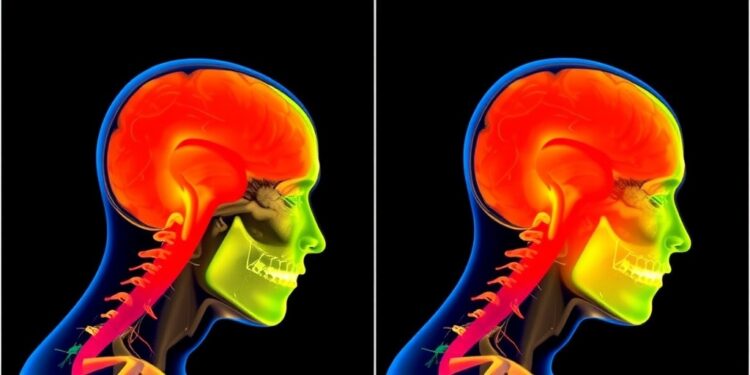Vibrotactile perception has emerged as a focal point in the realm of sensory input for individuals afflicted with Parkinson’s Disease (PD). As researchers continue to explore innovative therapeutic avenues, the significance of anatomical location in delivering vibrotactile stimulation becomes increasingly pronounced. This study’s findings reveal that where a tactile cue is applied can drastically influence its perceptibility, particularly for patients struggling with the debilitating symptoms of PD.
The inability to perceive tactile cues can exacerbate issues commonly faced by those with PD, such as freezing of gait (FoG). FoG refers to episodes when an individual feels as if their feet are glued to the ground, often exacerbated by external factors such as stress, distraction, or environmental obstacles. The implementation of reliable sensory cues, such as vibrotactile input, can provide the necessary support for these individuals to navigate their environment more safely and effectively. For vibrotactile stimulation to be effective, it must be placed at anatomical locations where tactile perception is optimal.
Research has highlighted variations in tactile perception between healthy individuals and those suffering from neurological disorders like PD. Traditional studies predominantly focused on the comparative analysis of vibrotactile feedback among healthy participants. Various anatomical locations such as the fingers, wrists, thighs, shins, and torso were examined to identify where individuals best perceived tactile input. However, this exploration has been largely absent when it comes to understanding the needs and perceptions of individuals with PD.
In a groundbreaking study, researchers engaged twenty-one individuals with PD to understand how anatomical location affects vibrotactile perception. This clinical trial was designed not only to fill this research gap but also to provide insights into how best to tailor sensory cues for this demographic. Importantly, the study also included twenty-one age-matched healthy individuals to draw a comparative analysis of the differences in vibrotactile perception between the healthy cohort and those with PD.
The results of this meticulous research reveal fascinating insights. For healthy participants, both the wrist and thigh emerged as particularly strong anatomical sites for vibrotactile perception. Astonishingly, these locations were accurately identified 100% of the time. Following closely behind was the finger, which boasted a correct identification rate of 98%. These findings indicate a statistical edge (p < 0.05) over other tested anatomical locations, underscoring the importance of location in vibrotactile cues for healthy individuals. Contrastingly, the data diverged when analyzing the responses from participants with PD. For this demographic, the thigh stood out as the most optimal anatomical location for vibrotactile stimulation. This location was accurately identified 96% of the time by the participants, including those with advanced symptoms. The wrist followed closely behind, with a correct identification rate of 92%. Significantly, the correct identification rate for the thigh remained statistically superior to all other locations except the wrist, highlighting its clinical relevance. These findings bear tremendous implications for the therapeutic strategies employed to assist individuals with PD. Clinicians can leverage this research to make informed decisions regarding the best anatomical locations to apply vibrotactile cues, thereby enhancing tactile perception and promoting better mobility in these patients. Understanding that the perception of these cues differs between healthy individuals and those with PD allows for a more nuanced approach to treatment and rehabilitation. The study's clinical significance lies not only in the findings themselves but also in how they can reshape existing protocols for patient care. Using the right anatomical locations for vibrotactile inputs could prove to be a game-changer, significantly reducing the experiences of FoG and other gait-related issues in individuals with PD. In a world where the complexities of Parkinson's disease can lead to significantly reduced quality of life, such breakthroughs shine a glimmer of hope. As research continues to evolve, further inquiries are encouraged in the field of vibrotactile feedback and its applications. A deeper understanding of how different populations perceive tactile sensations will be instrumental in devising effective therapeutic models aimed at alleviating the symptoms of various neurological disorders. This pioneering work exemplifies a shift towards a more individualized approach to treatment in the realm of neurorehabilitation. With the right anatomical insights, future therapies can be tailored to the unique needs of people living with Parkinson’s Disease, enhancing their ability to interact with their surroundings and regain a sense of control over their movements. The intersection of technology, health, and neuroscience holds the potential for unprecedented advancements in treating PD. This research represents a vital step forward, affirming the necessity of grounded approaches that acknowledge the anatomical variations in tactile perception among different populations. Continued efforts to refine and expand upon this foundational research promise to facilitate the development of cutting-edge therapies that are fine-tuned to the perceptual realities of those with neurological challenges, thereby improving the everyday experiences of countless individuals living with Parkinson's Disease. By focusing on anatomical locations and the specific needs of individuals with PD, scientists not only address practical concerns but also offer profound insights into the broader implications of sensory perception in neurological disorders. Harnessing this understanding could open new pathways in the quest for effective interventions and therapeutic models tailored for individuals grappling with Parkinson's Disease and beyond. Subject of Research: Vibrotactile perception in individuals with Parkinson’s Disease and the significance of anatomical locations.
Article Title: Identification of anatomical locations: its relevance for vibrotactile perception of individuals with Parkinson’s disease.
Article References: Raghuvanshi, A., Pallavi, P., Chhatlani, R. et al. Identification of anatomical locations: its relevance for vibrotactile perception of individuals with Parkinson’s disease. BioMed Eng OnLine 24, 21 (2025). https://doi.org/10.1186/s12938-024-01326-9
Image Credits: Scienmag.com
DOI: https://doi.org/10.1186/s12938-024-01326-9
Keywords: Vibrotactile perception, Parkinson’s disease, sensory cues, anatomical locations, freezing of gait, neurorehabilitation.
Tags: anatomical locations for tactile stimulationeffective therapeutic approaches for Parkinson’s.enhancing sensory cues for Parkinson’sfreezing of gait in PDinnovative therapies for neurological disordersoptimizing vibrotactile stimulationperceptibility in Parkinson’s patientsresearch on tactile perception variationssensory input for Parkinson’s Diseasesensory navigation support for PDtactile feedback in health vs. diseaseVibrotactile perception in Parkinson’s





